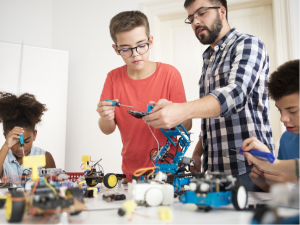
28 Mar Motivational activities in early childhood education
Motivation is vital, especially for the little ones, which is why at UNIR we propose a series of motivational activities for Early Childhood Education.
A child who comes to class eager to learn is every teacher’s dream. To achieve this, educators try to motivate students from the earliest stages. Motivation is complex because it is made up of various conditioning factors: to achieve an objective, a need must be created, but also a desire and, above all, expectations. Motivation is vital, especially for the little ones, which is why at UNIR we propose a series of motivational activities for Early Childhood Education.
In reality, motivation is very important for everyone. Although it is true that it is even more important for children, especially in Early Childhood Education. Motivation in school is an internal process and depends on their curiosity and interest. However, getting a child to be motivated not only concerns the subject himself, but also that her family and social environment encourage him.
School motivation is, therefore, a factor that determines the ability to learn and a psychological process that determines the approach to study, perform tasks, and, above all, have an interest in learning and discovering new things.
A student will listen to the explanations of the teacher, will participate in the classroom, and, in addition, will have an increasing motivated desire to know and learn.
Examples of activities to motivate your Early Childhood Education students

Do Sport
Although it seems a cliché, it is not. Playing sports, regardless of the student’s age, is key to increasing motivation. Playing sports should be mandatory for all children and the motto ‘ healthy men in healthy body’ is a good example. It is more than recommended that schoolchildren have some extracurricular sports activity. In addition to the Physical Education that they practice at school.
If the student sees that by making an effort he physically achieves achievements, he will assimilate that the effort is equal to the result, he will be increasingly motivated and, in addition, he will be able to apply it to his studies and his behavior in the classroom. Obviously, sport must be healthy and the level of competitiveness must always be controlled. In many cases, excessive competition can end in frustration.
Have Hobbies Or Hobbies
What adult doesn’t have at least one hobby? The same thing happens with children. It can be sports, painting, music, chess, dance… It has been shown that motivation increases with hobbies and these arise from trying new activities. In this way, the student will “break” the fear of trying new things and face new challenges. Families here have to be proactive. It is essential to observe the child and get to know him well to determine which activities he may like the most.
Introduction To New Technologies
Sooner or later, students have to learn and become familiar with new technologies. It is very important to know how to distinguish between excessive and inappropriate use of mobile phones, computers, tablets, and other electronic devices, and educational use. Thanks to gamification they will be able to learn spelling, math, or science while having fun.
ArtWorks And Crafts
There is nothing more motivating and rewarding for a child than to make something for himself. Whether it is a clay figure, painting a picture. Or playing with modeling clay. With this, fine motor skills and spatial notions are worked on and, in addition, it will help the student to see and understand the world in a different way when they are an adult.
In addition to all of the above, the following are recommended:
A smile is essential. If we return a smile to them every time they do a task correctly, they will be sufficiently rewarded.
The game is key. Therefore, as far as possible, a game approach must be found in everything that is taught. This helps students to be more active and participatory.
Talks and conversations in assembly. Talking with them is one of the things that encourages them the most because almost all children want to contribute their ideas, concerns, tell what has happened to them, etc.
Puppets or puppets. With these tools, children stimulate language, imagination, creativity… It is an ideal way of interacting.
Group outings or excursions. They are very effective because it stimulates them to get out of the classroom and enjoy their classmates in a different environment.
In some centers, the method of prizes or rewards is chosen for doing things well: recognizing their merits through diplomas made in the classroom, crowns, stickers, small gifts and even with affective relationships, such as a kiss or a hug. . In others, positive discipline is chosen in which there are no punishments, horizontal relationships and mutual respect are encouraged. This does not imply dispensing with limits. But rather focusing attention on problem-solving. And focusing on the actions that have been done wrong, explaining the consequences they cause.
Children’s motivation is key in learning. For this, it is essential that the teacher has diverse resources that know how to connect with the interests of the children to capture their attention and curiosity.
You may also be interested in 5 Tips To Enjoy With Children In New York

Sorry, the comment form is closed at this time.